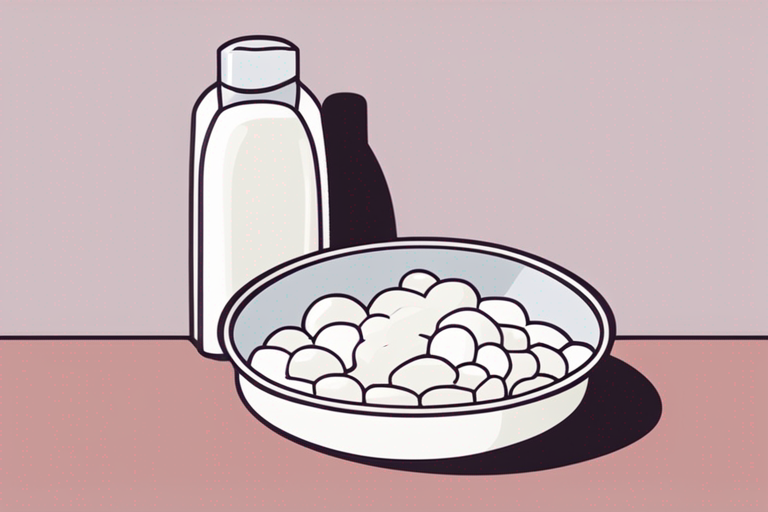
When Does Powdered Sugar Expire: A Comprehensive Guide
When Does Powdered Sugar Expire: A Comprehensive Guide
Powdered sugar, also known as confectioner's sugar or icing sugar, is a staple in many baking recipes. It adds sweetness and texture to a wide variety of dishes, from cakes and cookies to frostings and glazes. But like any food product, powdered sugar does have a shelf life. In this blog post, we'll explore when powdered sugar expires, how to store it properly, and tips for ensuring its safety and quality.
Still unsure if This Food is safe?
Every situation is different. Get a personalized food safety verdict for your this food based on the date, storage, and condition — in seconds.
👉 Check Food Safety NowUnderstanding Powdered Sugar Shelf Life
Powdered sugar typically has a long shelf life due to its low moisture content, which inhibits the growth of bacteria and mold. However, it can still degrade in quality over time. Here are some key factors that can affect the shelf life of powdered sugar:
Factors Affecting Expiration Date
-
Storage Conditions: Proper storage is crucial in extending the shelf life of powdered sugar. Exposure to moisture, heat, and light can lead to clumping, discoloration, and flavor changes.
-
Packaging: Sealed packaging helps protect powdered sugar from moisture and contaminants. Once opened, transfer it to an airtight container to maintain its quality.
-
Contamination: Always use clean, dry utensils when handling powdered sugar to prevent contamination.
Expiration Timeframe
Powdered sugar does not have a strict expiration date like perishable foods, but it can lose quality over time. Here's a general guideline:
- Unopened Package: Can last indefinitely if stored properly.
- Opened Package: Best used within 18-24 months for optimal freshness.
Proper Storage Tips
To maximize the shelf life of powdered sugar and maintain its quality, follow these storage tips:
Storage Containers
- Choose an airtight container to prevent moisture absorption and odors from affecting the sugar.
- Glass or plastic containers with tight-sealing lids are ideal for storing powdered sugar.
- Ensure the container is clean and dry before transferring the sugar.
Storage Conditions
- Store powdered sugar in a cool, dry place away from direct sunlight and heat sources.
- Avoid storing it near strong-smelling foods, as powdered sugar can absorb odors.
- Check the storage area periodically for any signs of moisture or pests.
Additional Tips
- Consider placing a silica gel packet in the storage container to absorb excess moisture.
- Label the container with the date of purchase or opening to track freshness.
Signs of Spoiled Powdered Sugar
While powdered sugar does not spoil in the same way as perishable foods, it can degrade in quality. Here are some signs that powdered sugar may have gone bad:
Indications of Spoilage
-
Clumping: If the sugar has hardened into clumps or lumps, it may have absorbed moisture.
-
Off Odors: A musty or rancid smell indicates the sugar is no longer fresh.
-
Discoloration: Any noticeable changes in color, such as darkening or yellowing, suggest degradation.
If you observe any of these signs, it's best to discard the powdered sugar to avoid compromising the taste and texture of your baked goods.
Safety Precautions
Ensuring the safety of powdered sugar involves more than just checking for spoilage. Here are some additional safety precautions to keep in mind:
Still unsure if This Food is safe?
Every situation is different. Get a personalized food safety verdict for your this food based on the date, storage, and condition — in seconds.
👉 Check Food Safety NowHygiene Practices
- Wash your hands before handling powdered sugar to prevent contamination.
- Use clean utensils and containers when scooping or measuring the sugar.
- Avoid blowing on powdered sugar to prevent the spread of germs.
Cross-Contamination
- Store powdered sugar away from raw meats, seafood, and other potential contaminants.
- Use separate utensils for handling different food items to prevent cross-contamination.
Allergen Awareness
- Be aware of any potential allergens in the powdered sugar, such as wheat or cornstarch.
- Label containers clearly if the sugar has come into contact with allergenic ingredients.
Conclusion
In conclusion, powdered sugar can last a long time if stored properly and handled with care. By following the tips outlined in this guide, you can ensure that your powdered sugar remains fresh, safe, and ready to enhance your favorite recipes. Remember to check for signs of spoilage, practice good hygiene, and store the sugar in optimal conditions to enjoy its sweetness to the fullest.

Still unsure if This Food is safe?
Every situation is different. Get a personalized food safety verdict for your this food based on the date, storage, and condition — in seconds.
👉 Check Food Safety NowAuthoritative Food Safety References
These agencies and university labs inform every tip and health precaution we publish.
USDA FoodKeeper – Cold Storage Guidelines
Official refrigerator, freezer, and pantry timelines maintained by the U.S. Department of Agriculture.
Visit USDA FoodKeeperFDA Produce Safety Rule & Grower Guidance
Field-to-fridge handling practices that prevent contamination of fruits, vegetables, and leafy greens.
Visit FDA Produce SafetyCDC Foodborne Illness Prevention Hub
Surveillance-backed guidance on pathogens, symptoms, and steps to reduce foodborne illness risk.
Visit CDC Food SafetyUC Davis Postharvest Technology Center
University research detailing optimal storage atmospheres for produce after harvest.
Visit UC Davis PostharvestPenn State Extension – Home Food Preservation & Safety
Peer-reviewed extension bulletins on safe canning, chilling, and reheating practices.
Visit Penn State Extension